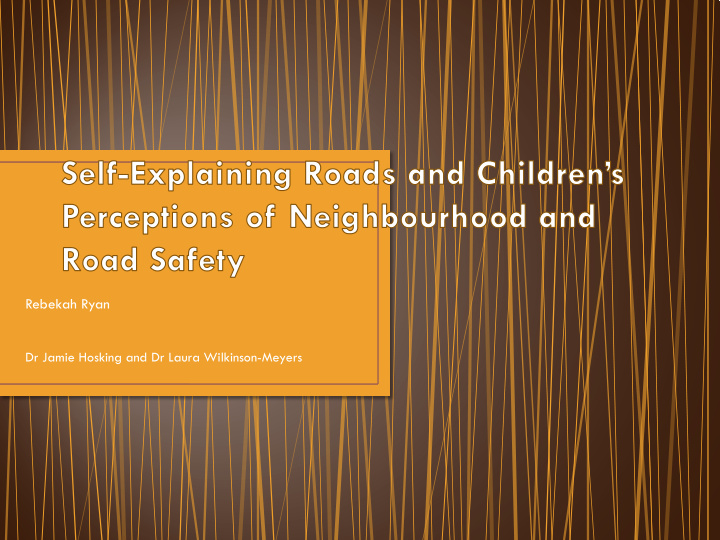



Rebekah Ryan Dr Jamie Hosking and Dr Laura Wilkinson-Meyers
• “Undertaking research with children and not ‘on children’” (Mitchell, Kearns, & Collins, 2007) • “Their understanding of the world cannot be accurately filtered through the an adult lens” (Loebach & Gilliland, 2010) • To put children and young people first (Auckland Plan, 2011) • “Both children and adults should be involved in policy making” (Chadborn et al, 2013) • From protection to participation (Ross, 2007) Note: the photos of children included in this presentation are not of the participants involved in the study.
• “The use of road designs that evoke correct [or desired] expectations and driving behaviours from road users.” (Charlton et al. 2010, p.1989) Average speed on local roads reduced to 30km/h • Reduced rates of traffic crashes • Increased pedestrians counts •
How has a self-explaining roads intervention affected children’s perceptions of their neighbourhood environment and their experiences as pedestrians?
• Approaching Pt England School • Negotiating a research project • Ethics • Research with children • Consent • Participants • Aged 10-13 • N=16
• Appropriate method for children of this age group • Set in classroom environment • Four themes • Perceptions of neighbourhood safety and danger • SERs and neighbourhood safety • Walking, cycling and playing • Parents’ perceptions
• Purpose: to feed into the focus group discussion • “Pt England Investigates” • Class instructions • Observation
• Happiness, respect for one another, trust • “Less parties” • When kids are safe • “Less speeding cars” • “Less traffic” • Driving on the correct side of the road
• Traffic islands • “A place to play” • Slows cars down • Creates traffic vs reduces traffic • Makes crossing the road easier, but can reduce driver’s visibility of children • On-street parking
• Crossing roads • Dodging islands • Playing rugby • Less traffic
• Annoyed • Slows them down; time consuming • Less parking • Like them • Makes it easier for their children to cross the streets Awareness of different perspectives
• Self-explaining roads make it easier for children to cross roads, and therefore increase road safety for pedestrians. • Self-explaining roads increase a sense of safety by reducing traffic and vehicle speeds. • Children have different priorities from their parents (and from other age groups)
• Filled a gap in the • Small number of literature – children’s participants and one voices focus group • Engagement with school • Would have been good – win-win to use class project data • Appropriate participant selection
• Future Streets Research • Auckland Transport • Engagement with school
• Learning from our engagement with the school, and the development of a class project where children become the researchers. • Opportunities to use photovoice and other creative methods to answer the same, or similar research questions.
Auckland Plan 2011 • Chadborn, N. H., Gavin, N. T., Springett, J., & Robinson, J. E. (2013). “Cycling–exercise or trying to • stop pollution”: methods to explore children's agency in health and climate change. Local Environment, 18(3), 271-288. Charlton, S., Mackie, H., Baas, P., Hay, K., Menezes, M., & Dixon, C. (2010). Using endemic road • features to create self-explainig roads and reduce vehicle speeds. Accident Analysis and Prevention, 42 (6), 1989-1998. Loebach, J., & Gilliland, J. (2010). Child-led tours to uncover children's perceptions and use of • neighborhood environments. Children Youth and Environments , 20 (1), 52-90. Mackie, H., Charlton, S., Baas, P., & Villasenor, P. (2013). Road user behaviour changes following a • self-explaining roads intervention. Accident Analysis & Prevention, 50 , 742-750. Mitchell, H., Kearns, R., & Collins, D. (2007). Nuances of neighbourhood: Children's perceptions of the • space between home and school in Auckland, New Zealand. Geo Forum, 38 (4), 614-627. Ross, N. (2007). 'My Journey to school...': Foregrounding the meaning of school journeys and children's • engagements and interactions in their everyday localities. Children's Geographies, 5 (4), 373-391.
Recommend
More recommend